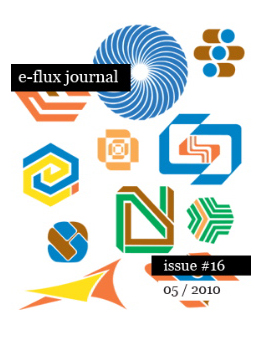May 2010
Available online:
http://e-flux.com/journal
Diedrich Diederichsensee full essay hereBilal Khbeiz looks at Michael Jackson’s slow march towards death, how it began at the height of his fame and ended in rumors that the King of Pop’s fall was linked to a common over-the-counter drug. As a superstar without any particularly good reason for dying, what was it that slowly killed him? The answer may be found in Jackson’s transformation of his body into the image of an unstoppable performer, a shrine that would beckon visitors for eternity. (see full essay here)
Liam Gillick asks whether the figure of the artist is really so different from that of the freelance knowledge worker, perched before a laptop by day, stressing over deadlines by night. How is the work of producing art different than the work of work? While the two may use the same tools, and even produce similar forms, there are certain crucial, yet potentially phantasmic differences that distinguish them in places where unstable decision-making processes are welcomed and sustained, and where apparent complicity is directed by choice rather than program. (see full essay here)
Hu Fang tells the story of Wu Yongfang, an artist who fasts publicly in order to test his own limits and demonstrate a form of raw reality using the power of his will and life. However, when a Hunger Art exhibition is mounted to promote a new luxury real estate development called “Fragrant Garden Villas,” the public nature of his search for inner enlightenment is beset by many of the problems of spectacle and performance. (see full essay here)
Paul Chan considers the importance of being part of a community today and makes a necessary distinction between a community—and what it offers—and the networks formed by “online communities.” Whereas, according to Chan, the kind of communication fostered by online networks does not “merit the focus and care that genuine communication demands, and dies off as quickly as it materializes, which in turn calls out for even more communication to be generated to compensate for the loss,” actual communities of people provide an opportunity for individuals to share their incompleteness, to complete each other mutually. (see full essay here)
Anton Vidokle warns against the increasing tendency for curators to assume a kind of authorship over exhibitions that can usurp the role of the artist. While a pattern of privatization occurring in cultural institutions throughout the world has in many ways left curators less accountable to bureaucratic bodies and more free to experiment under an expanded framework of cultural practice, a dangerous situation emerges when curators, while still acting in their capacity as institutional agents, begin to assume a degree of sovereignty that encroaches upon the role of artists as actual free agents. (see full essay here)
Nataša Petrešin-Bachelez continues her series “Innovative Forms of Archives” examining cases in which “it might seem that the role of the artist and that of the museum have changed places.” This time she looks at the Slovene group IRWIN, who in the 1990s used their opportunity to gain access to the West to ascertain and catalogue that which particularly defined their own working conditions as artists in Eastern Europe, and the Hungarian artist Tamás St. Auby, founder of the International Parallel Union of Telecommunications (IPUT) and creator of the Portable Intelligence Increase Museum. (see full essay here)
Dieter Roelstraete‘s point of departure is a footnote in his text in issue no. 11 lamenting the fact that contemporary art and the contemporary art world have become by and large indistinguishable from each other. Here he offers a series of ten distinguishing characteristics of the contemporary “mist,” a murkiness that has not only obscured the purpose of asking crucial, ontological questions concerning the nature of “art,” but has also managed to produce an entire aesthetics of its own, permanently casting a state of general confusion into relief—a floating, oceanic, drifting world as master institution. (see full essay here)
The third and final installment in Sven Lütticken‘s series “Art and Thingness” reflects on how thingness has been treated in recent works of art. Beyond specific contemporary interest in the collapse of subject-object dichotomies, Lütticken finds in the tension around objecthood an ongoing critical discussion within modernity itself. Just as Beuys’ works are commonly seen as drawing on a private mythology, so too should they be taken as objects containing at least some part of Beuys’ mythos in their thingness. (see full essay here)
And finally, we visit Paris in an open letter to Clifford Irving . . .
—Julieta Aranda, Brian Kuan Wood, Anton Vidokle
